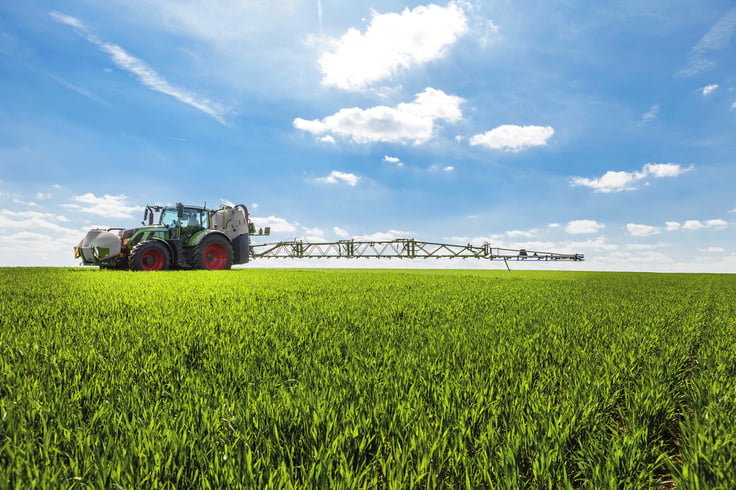In agriculture, diaphragm pumps are crucial because they are used inside every sprayer boom or sprayer system.
Right away, we can list the main advantages of their use in agriculture:
- Excellent priming and self-priming;
- Good dry running;
- Mechanical and chemical resistance.
Thanks to these features, the diaphragm pumps are ideal for spraying and weeding treatments of agricultural crops such as cereals, vegetables, orchards, vineyards and olive groves.
Even before that, it is very useful to understand how a diaphragm pump works in detail.

OPERATING ELEMENTS:
Diaphragm pumps belong to the group of positive displacement pumps, which exploit the alternating changes in the volume of a chamber (expansion and contraction) to generate pressure imbalances between the chamber and the adjacent spaces.
To facilitate understanding, we can mention an example of an everyday use of a diaphragm pump: the standard injection syringe.
Exactly as in the syringe, the liquid is first drawn in thanks to the vacuum created inside the pumping chamber. Trying to compensate for the pressure imbalance (principle of communicating vessels), the fluid is naturally sucked in towards the lower pressure space (inside the syringe, for example), giving rise to the so-called suction phase.
In the next step, the pressure inside the pumping chamber increases (in the syringe, this is done by pushing the finger on the piston). In this phase there is an increase in pressure inside the chamber, which pushes the fluid to the outside by the usual principle of communicating vessels: this is called phase of delivery or outlet.

In diaphragm pumps, just as in syringes, expansion and contraction are generated by means of the alternating oscillations of an elastic element, called the diaphragm.
The sum of the two phases of suction and delivery creates a complete pumping cycle (or period).
Since the chamber has a defined and invariable maximum volume, the volume pumped in each cycle is constant, regardless of the pressure.
For this reason, positive displacement pumps are called volumetric or constant flow pumps.
Therefore, to vary the flow rate of a diaphragm pump (normally expressed in l/1' or in GPM) it is necessary to increase or reduce the number of cycles per minute.
On the contrary, the pressure attainable with a positive displacement pump has no theoretical limits, since it is only limited by the structural strength of its components and its constructional engineering.
Diaphragm pumps, as well as piston pumps, belong to the group of volumetric reciprocating pumps, since the diaphragm makes an oscillatory reciprocating movement, i.e. it moves up and down, exactly as it does in the syringe.
OPERATION:
The reciprocating pump must be driven by an external power source - which may be a tractor power take-off (PTO), or an electric, hydraulic motor or an internal combustion engine.
The pump is connected to the motor through a mechanical transmission system consisting of connecting rod - crank, which transforms the rotary movement of the crankshaft into the reciprocating movement of the diaphragm.
This determines that each revolution of the crankshaft corresponds to a complete pumping cycle (suction and delivery).
IN SHORT:
- Concept of volumetric pump: the volume pumped is constant in each cycle (the syringe size is X ml, and cannot vary).
- Concept of reciprocating pump: in each cycle, the diaphragm makes an oscillatory movement by displacing alternately between two points, thus generating a suction phase and a delivery phase. The distance between these two points, which we will see more about later, is called the stroke.
DISPLACEMENT:
The volume displaced by a pumping chamber in a complete cycle is defined as displacement (exactly as in the internal combustion engines), and is obtained by multiplying the stroke of the diaphragm by its area.
The stroke is the distance between the dead centers of the diaphragm:
The lower dead centre, which is reached in the suction phase;
- The top dead centre, which is reached in the delivery phase.
According to an algebraic formula, the volume is obtained by the following multiplication:
V = π ∙ (D/2)² ∙ C
Where C is the stroke and D is the diameter (or bore) of the diaphragm.
Normally, the pumps are equipped with several diaphragms, so to obtain the displacement of a pump it is sufficient to multiply the single displacement by the number of diaphragms. This gives the total volume.
V tot = V ∙ i
Where i means the number of diaphragms/cylinders
Finally, to obtain the flow rate of a pump in liters per minute, or GPM, simply multiply the value obtained by the number of revolutions per minute of the shaft (RPM).
V/min = V tot ∙ RPM
Now that you’ve discovered the more specific details of how a diaphragm pump works, it may be helpful for you to know how to carry out proper maintenance.
It will also help you to know that each diaphragm pump needs its own oil for proper operation.












